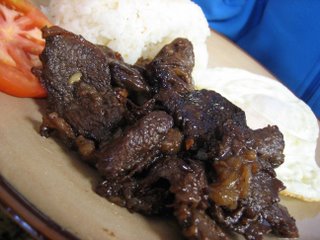Sahara Falafel - Anaheim
 Faceless figures in flowing ghutras and thobes stood defiantly, looking out at a vast, barren, and desolate landscape. Beyond them, nothing but sand. Nearby, camels are slumped in repose, shielding their heads from the unrelenting sun. On the distant horizon, a blurry outline of a city, shimmering in the updraft emanating from the dunes. Or was it just a mirage?
Faceless figures in flowing ghutras and thobes stood defiantly, looking out at a vast, barren, and desolate landscape. Beyond them, nothing but sand. Nearby, camels are slumped in repose, shielding their heads from the unrelenting sun. On the distant horizon, a blurry outline of a city, shimmering in the updraft emanating from the dunes. Or was it just a mirage?Where were we? Not where you'd think. The scene I just described is depicted in a mural, painted on the walls of Sahara Falafel, a tiny restaurant in the Anaheim's Little Gaza District on Brookhurst Street.
With Disneyland mere blocks away, we were in the heart of Orange County -- but as we waited for our orders of food to be prepared, we felt as if we had travelled to a distant place, far away from Stepford, and somewhere closer to the Sahara Desert itself.
Also waiting was a young woman, dressed in a traditional black hijaab, who smiled as her three-year old son stared at me curiously with wide eyes. I waved to him, grinning. He giggled brightly, while at another table, a group of bookish young men chattered away in Arabic, chewing on skewered meat and scooping up hummus with rolled pieces of pita bread.
Behind the counter, a gruff elderly man with a wind-weathered face fried small batches of falafel in a small teflon pot, slowly turning the balls in the hot oil with a slotted spoon. Next to him, an frail-looking old woman, also in a hijaab, tended a grill no bigger than a school desk, tenderly flipping kaftas, kabobs, and vegetables as they roasted over a lapping fire. Between them, rotating on a vertical spit, spun what was left of the shawarma. Since it was past nine-thirty at night, the slender cylinder of meat was shorn down almost to the metal rod, looking like a spent apple core.
After a good fifteen minutes, our food was ready, served to us by the old woman.
What she brought was the most gorgeous mound of food to grace a styrofoam plate I had ever seen. This was the BBQ Combination Plate ($10.95). The largest well of the plate was occupied by a grilled tomato, onion, a grilled beef sausage called kafta and a skewer of seasoned white-meat chicken over fluffy rice, studded with bits of fresh parsley. On the side; a simple salad dressed with lemon juice and a serving of hummus, dimpled with two glistening puddles of olive oil.
Also, almost unnoticed by us at first, was a thimble-sized plastic container of garlic paste called toum. Being fans of the acclaimed Zankou Chicken garlic paste, we hastily ripped off a ragged swatch of pita bread and dabbed it into the innocent-looking concoction. A split second after the white substance touched our tongues, a searing hit of unmitigated garlicness sucker-punched our throats and burned a path clear into our sinuses.
We winced. "Pain. Oh the pain!," we cried as our eyes welled up with tears. It stung, but it stung good.
If Zankou's garlic paste was acetic acid, this was downright hydrochloric. While the former toned down their version with boiled potato, it was evident Sahara Falafel did not. Instead, they utilized nothing but straight up raw garlic, salt, lemon juice, and olive oil. Untamed, undiluted, this was toum at its purest and most potent: a blissful dose of garlic heaven.
Respecting its ferocious power, I used this edible napalm sparingly, slathering a narrow swath on the inner surface of my pita. Then I stuffed the pocket with kafta and chicken before I drug the open end through some hummus. As I bit into it, the kafta, spiced lightly with cloves and cinnamon, crumbled like a firm and dense ground-beef meatball. But the toum still managed to bite back.
 The Falafel Sandwich ($3.95), also utilized a smear of toum, but was balanced by flaked chili, tahini, lettuce and tomato. The wrap's main attraction was, of course, the falafel.
The Falafel Sandwich ($3.95), also utilized a smear of toum, but was balanced by flaked chili, tahini, lettuce and tomato. The wrap's main attraction was, of course, the falafel.The crunchy deep-fried orbs of well-spiced, mashed chickpea possessed a dark mahogany crust with the rough and tumble texture of gravel; pebbly and crackly. Hiding beneath was a potato-soft and ultra-savory center so rich in flavor, it easily substituted for meat.
After polishing off the meal, the toum we consumed relented, following us home, staying with us through the night and the morning after. It lingered in our breaths and in our consciousness. Garlic heaven turned into a garlic demonic possession.
There, in the thick haze of our stinky, smelly burps was the souvenir from our trip to Little Gaza.
Sahara Falafel
(714) 491-0400
590 S Brookhurst St
Anaheim, CA 92804












